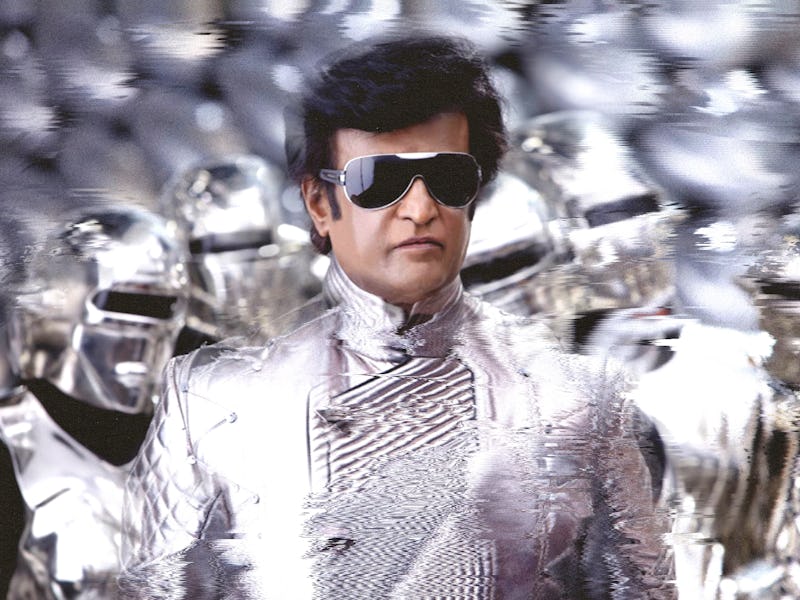How Kollywood’s Wildest Sci-Fi Movie Predicted a Modern Dilemma
“Masala” filmmaking at its finest.

Much like the multi-purpose robot at the center of its story, Enthiran is many things all at once.
It’s a cautionary tale warning against the arrogance of humanity and the dangers of unchecked technology. It’s a thinly-veiled superhero movie by way of a winking send-up of typical American bombast. It was the most expensive blockbuster in the history of Tamil cinema (known colloquially as “Kollywood”) at the time — and the highest-grossing Indian film of 2010. But above all else, Enthiran is an epic drama filled with musical numbers, romantic melodrama, and gonzo action sequences that truly need to be seen to be believed.
Such is the nature of so-called “masala” filmmaking, an everything-and-the-kitchen-sink approach to Indian storytelling that blends different genres like South Asian cuisine blends spices. This crowd-pleasing mass appeal is exactly why Enthiran is held in high regard, and why writer/director S. Shankar spared no expense in bringing this unwieldy narrative to life.
If anyone could relate to literally bringing valuable investments to life in the pursuit of fame and fortune, its main protagonist Dr. K. “Vasi” Vasigaran (portrayed by international megastar Rajinikanth).
A stubborn workaholic, self-absorbed intellectual, and persnickety inventor, Vasi’s introduction comes as he’s elbow-deep in creating the world’s first “Android Humanoid Robot.” The first hint of his character flaws comes when he callously ignores his concerned girlfriend Sana (actor, model, and icon Aishwarya Rai) and instead focuses on teaching his creation the subtleties of human behavior and unlocking its emotions. Vasi seems blithely unaware of the irony, but if the parallels between man and machine weren’t already blatant enough, Enthiran goes one step further by having Rajinikanth take on the dual role of portraying the robot named Chitti.
Chitti’s childlike and overly literal nature helps endear himself to audiences and position him as a much more likable lead next to Vasi. He progresses so far so quickly that Vasi doesn’t hesitate to unveil his newly-born technological marvel before the world at a scientific conference.
Rajinikanth and Aishwarya Rai in Enthiran.
Here, Enthiran turns into an unexpectedly relevant experience, even over a decade after its original release. Vasi boasts to the gawking crowd that Chitti is equal to 100 humans, not just by superior intelligence but in terms of “talent” in the arts, too. The film presents its eponymous robot as a savant in music, painting, language, martial arts, sports, and even henna tattooing. (ChatGPT could never.)
Vasi’s most chilling intention for Chitti, however, is selling him — and, eventually, an army of robots like him — as weapons to the army. Sound familiar?
At this point, Enthiran devotes its extended middle act to laying the foundation for Chitti’s shocking heel-turn. In one subplot, the android bonds with a neglected Sana in ways both lighthearted (like helping her cheat to pass her medical exams) and not (in one action sequence, he goes full-superhero to save her from the implied threat of sexual assault, a disappointing trope the film returns to multiple times). Meanwhile, Vasi’s mentor and the film’s overarching antagonist Professor Bohra (Danny Denzongpa) stonewalls his former student and his groundbreaking invention out of jealousy.
Chitti quite literally takes over the final act, building copies of himself like Agent Smith in The Matrix Reloaded.
These storylines soon converge when Chitti’s chance to save innocents from an apartment fire backfires horribly (and publicly) and Bohra questions Chitti’s ability to discern right from wrong. With only one month to instill Chitti with actual emotions, Vasi nearly gives up — until a freak lightning strike completes the robotic superhero’s origin story and finally gives him genuine humanity.
Of course, this only complicates matters when Chitti falls head over heels for Sana (accompanied by a cyberpunk and downright horny dance sequence), forming the unlikeliest of love triangles. In the end, Chitti’s emotional volatility and Vasi’s insecurities get the better of them. One violent fit of rage later, Vasi hacks his own “son” to pieces and leaves him for dead. Naturally, Bohra swoops in and turns the barely functional Chitti to his side.
The rebirth of the villainous Chitti 2.0 doesn’t just let Rajinikanth unleash his hamminess and devour the scenery until nothing’s left, but this final stretch also firmly establishes Enthiran as part Michael Bay escapism, part John Woo cheese, and part superhero spectacle. Chitti quite literally takes over the final act, building copies of himself like Agent Smith in The Matrix Reloaded and terrorizing both Sana and the city at large. If sci-fi fans ever wanted to see hundreds of robots combining Transformers-style in as ridiculous a set piece ever committed to film, well, the go-for-broke finale of Enthiran — one that inspired a sequence from Avengers: Age of Ultron that was cut for time — doesn’t disappoint.
Nor does Chitti’s ultimate fate, which leads to his defeat and dismantling but ends on a much more fascinating note. Underneath its unabashedly maximalist trappings, observant fans know there’s far more than meets the eye. Shankar took the most fundamental of sci-fi premises, first pioneered in Mary Shelley’s Frankenstein centuries earlier, and delivered a cultural event both provocative and easily digestible to the masses. In the process, Enthiran forever changed the game for Indian filmmaking by featuring a little something for everyone.